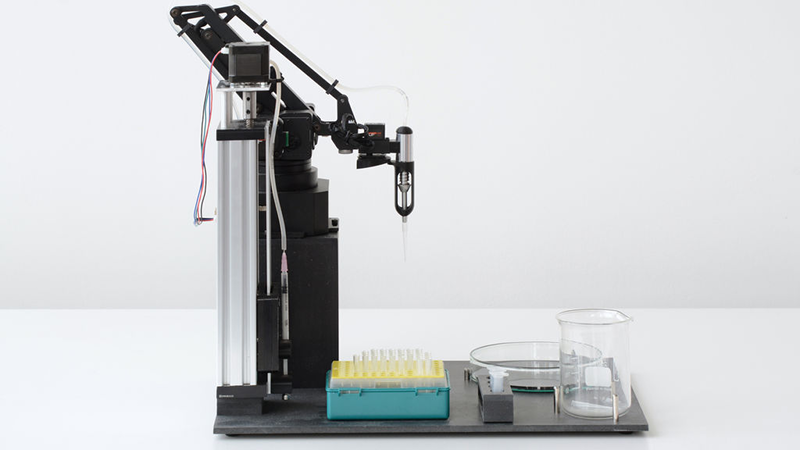When we took a biology lab, you had to use a mouth pipette to transfer liquids around. That always seemed odd to use your mouth to pick up something that could be dangerous. It’s also not very efficient. A modern lab will use a liquid handling robot, but these aren’t exactly cheap. Sometimes these are called pipettors and even a used one on eBay will set you back an average of $1,000 — and many of them much more than that. Now there’s an open source alternative, OpenLH, that can be built for under $1,000 that leverages an open source robot arm. You can find a video about the system below.
The robot arm, a uArm Swift Pro, is the bulk of the cost. The Pro can also operate as a 3D printer or a laser engraver with a little work. In fact, we wondered if you could use the arm to make a 3D printer and then print the parts you need to convert it to a liquid handler. Seems like it should work.
The 3D printed parts hold the pipette and syringe assembly. There’s also extra motors to operate the plunger, as you might expect.
For programming, the device uses Python and Blockly — the latter being used if you don’t want to write actual code. There’s an example bioprinting application and the post claims the accuracy is within 0.15 microliters.
Naturally, we thought of using it for solder paste. It really reminded us of many pastestruders we’ve seen in the past, but very precise.
















liquid handling robot on linear rails for quarter cost:
https://grabcad.com/library/3-axis-cnc-robot-arm-vl-1
In 1981-3 when my sister was studying O-grade Chemistry in a Scottish school, her friend Gavin sucked too hard on a pipette of sodium hydroxide and swallowed it. The teacher gave him a note saying he was allowed to buy all the salt and vinegar crisps in the school tuck shop to neutralise the alkali. By the time I took O-grade Chemistry three years later, pupils were supplied with rubber bulbs to provide suction instead.
Regarding opensource solutions, there’s also opentrons https://opentrons.com/ — Looks like they themselves started with a Cartesian 3-D printer frame + single or multichannel pipetter… and took off from there.
Not sure if things in practice are as simple as that, but if you already have an unused 3-D printer and are able to attach a pipetter to it, then their software might be able to help you convert this into a capable liquid dispenser.
Worth a try anyway :-)
I’ve used an opentrons robot and their documentation was miserable. Additionally they used 3d printed parts to activate normal pipette without using anything to adjust the volume of the pipette so all operations had to use one volume throughout the process. Wouldn’t trust anything made by these guys.
Thanks for the input Andrew. One of my colleagues bought one earlier this year, I’ll go and check how he’s getting on (if he’s already using it).
And thanks for posting our work! :)
Great to see it reaching the DIY community we intended it for.
A mouth pipette sounds like some kind of hazing.
Silly misleading article. Robotics can’t be the wrong solution for the wrong problem, no matter what the cost of the system. One thing tech enthusiasts often ignore is that even if you have a robot, you have to feed the robot. Someone is going to have to manually set up the materials for the robot to pick up and then dispense. In the vast majority of cases in a biology type lab, it’s a zillion times more efficient for a person to do it. It only works when you have to do something repeatedly for hundreds or thousands of identical samples or an identical operations. That only occurs in very limited number of high-powered research labs but mostly in industry. Both of those require outstanding support for their instrumentation, which comes from other companies who supply service engineers specialized to support the product. Hacking a robotic dispenser is probably going to result in some equipment being played with for a couple of weeks and then put up on a shelf somewhere forever, or until its parts taken and used for something else. Real labs cannot afford to waste time and resources and people chasing down diversions.
“That always seemed odd to use your mouth to pick up something that could be dangerous.”
I’ve often thought I wished my pets were smart enough to communicate with me. But then.. can you imagine being intelligent enough to understand germ theory but not having grasping hands with opposable thumbs? Can you imagine carrying things in your mouth? Cleaning yourself with your tongue?!?!
And then come to find out… dogs, cats, even most mammals with paws or hooves actually evolved from animals that DID have grasping hands! Most evolutionary niches actually lead to that prehensile-mouth kind of life. Ewww! It makes me feel so lucky to be born a human!